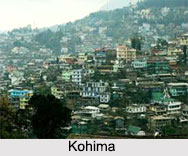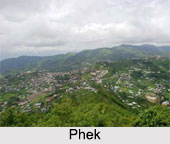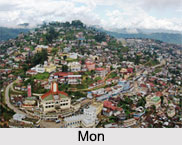 Cities of Nagaland covers the north eastern cities like Kohima, Phek, Mokokchung, Wokha, Zunheboto, Tuensang, Mon, Dimapur, Kiphire, Longleng and Peren. There are various festivals celebrated in the cities of Nagaland, making the state a land of festivals. The diversities in the altitude, latitude, climate and soil have given rise to a multiplicity of forest types in the different cities, ranging from tropical evergreen to temperate evergreen and the coniferous.
Cities of Nagaland covers the north eastern cities like Kohima, Phek, Mokokchung, Wokha, Zunheboto, Tuensang, Mon, Dimapur, Kiphire, Longleng and Peren. There are various festivals celebrated in the cities of Nagaland, making the state a land of festivals. The diversities in the altitude, latitude, climate and soil have given rise to a multiplicity of forest types in the different cities, ranging from tropical evergreen to temperate evergreen and the coniferous.
Kohima
Kohima is the capital city of Nagaland which shares its borders with Myanmar. It is known as the "Lands of Agami naga Tribes". Here the Hornbill festival is celebrated widely.
Mokokchung
 Mokokchung, one of the districts in Nagaland is the Home of the Ao Naga tribe. It covers an area of 1,615 sq km. It is bounded by Assam to its north, Wokha to its west, Tuensang to its east, and Zunheboto to its south. The physiographic division of the district shows six distinct hill ranges. The ranges are more or less parallel to each other and run southeast direction. Mokokchung District is bounded by the state of Assam to its north, Tuensang to its east, Zunheboto to its south and Wokha and Assam to its west, and lies between 93.53 and 94.53 Degrees Longitude and 25.56 Degrees Latitude.
Mokokchung, one of the districts in Nagaland is the Home of the Ao Naga tribe. It covers an area of 1,615 sq km. It is bounded by Assam to its north, Wokha to its west, Tuensang to its east, and Zunheboto to its south. The physiographic division of the district shows six distinct hill ranges. The ranges are more or less parallel to each other and run southeast direction. Mokokchung District is bounded by the state of Assam to its north, Tuensang to its east, Zunheboto to its south and Wokha and Assam to its west, and lies between 93.53 and 94.53 Degrees Longitude and 25.56 Degrees Latitude.
Phek
Phek is a town and a town Council in Phek district in the Indian state of Nagaland. This city is popular for its scenic beauty of vast hilly city life.
Zunheboto
Zunheboto is located in the area committee of Zunheboto district in the state of Nagaland.
Mon
Mon brings pictures of chiefs, tattooed faces of Konyaks and muzzle-loading guns which the ingenious Konyaks manufacture. It is 357km from Kohima via Dimapur and 280 km from Dimapur, 275km from Kohima via Mokokchung, Tamlu and Wakching. Mon headquarters, home of the Konyaks, was established at Chen and Mon villages land, being centrally located for the coronation of Anghs (Chiefs). Here, one can see the tattooed faces wearing feathered headgears and traditional dresses. Konyaks are adept artisans and skilled craftsmen.
Tuensang
 Tuensang is a city in Nagaland with the administrative headquarters of the Tuensang district.
Tuensang is a city in Nagaland with the administrative headquarters of the Tuensang district.
Peren
Peren is a small town in Nagaland with the district headquarters of the Peren district. Zeliang Tribe, Rongmei Tribe and Kuki Tribe are the main inhabitants.
Wokha
Wokha in Nagaland is the district headquarters of the Lothas. It is equidistant at 80 Km both from Kohima as well as Mokokchung in Nagaland. It is 58 Km from Furkating Railway Station (Assam). Wokha literally means census in Lotha. It was the place where the ancient Lothas counted heads before spreading out into the villages during their waves of migrations. There are monoliths (LOngzu) erected by their rich ancestors to exhibit their status. Lothas are know for their colourful dances and songs particularly Shanta. Tokhu Emong and Pikhuchak are their main festivals.
Dimapur
It is the largest city in Nagaland. Dimapur offers the scope of eco tourism and leisure tourism, because of the presence of resorts and hotels. It was the seat of Dimapur kingdom, which was the royal history of Nagaland. Dimapur Jain Temple is the popular place to attract the tourists.
Cities of Nagaland are draped in extensive bamboo groves that also provide the exact ambience for the cultivation of oak, chestnut, birch, magnolia, cherry, maple, laurel and fig, especially in the hill slopes. The main tribes inhabiting the cities of Nagaland are Lothas, Angami, Ao, Chakhesang , Chang, Khiamniungan, Konyak, Phom, Pochury, Rengma, Sumi, Sangtam, Yimchungru, Tangkhul and Zeliang. The cities have a rich heritage of handloom and handicrafts. The main cities are Kohima (the capital city),Wokha, Mon and Mokokchung .



















